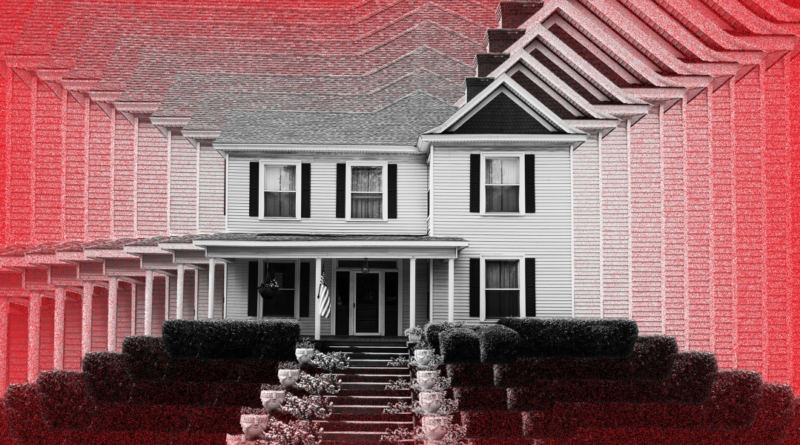A 1981-level mortgage rate shock has the housing market in a correction—these 7 leading research firms predict what's next for rates
Fast-forward to today, and the Fed’s ongoing inflation fight has once again spurred a mortgage rate shock. This spike in mortgage rates, which are up from 3.22% to 6.48% over the past 12 months, has pushed the U.S. housing market into a full-blown housing correction.
On one hand, 6% mortgage rates are hardly historically abnormal. On the other hand, that 3.22-percentage-point jump in mortgage rates over the past year has delivered an affordability shock that’s similar to the one dealt in 1981 when mortgage rates climbed 4.9 percentage points to 18%.
See, it’s less about the numerical mortgage rate and more about the total monthly mortgage payment as a percentage of new borrowers’ incomes. And when accounting for everything (i.e. home prices, incomes, and mortgage rates), the 2022 affordability squeeze is nearly on par with the 1981 affordability squeeze.
“Affordability has evaporated, and with it housing demand,” Mark Zandi, chief economist at Moody’s Analytics, tells Fortune.
This isn’t happening by mistake: Back in June 2022, Fed Chair Jerome Powell said the housing market needed to go through a “reset” in order to cool housing inflation and put the housing market and economy at large into better balance. That’s why the Fed, which halted its buying of mortgage-backed securities and jacked up the Federal Funds rate, put immense upward pressure on mortgage rates in 2022. At the end of the day, if housing affordability gets too “pressurized”—something we’re seeing right now—investors and first-time homebuyers alike will stop bidding up prices (i.e. slowing housing inflation), and homebuilders will then pull back (i.e. giving supply chains breathing room).
“For the longer term what we need is supply and demand to get better aligned so that housing prices go up at a reasonable level and at a reasonable pace and that people can afford houses again. We probably in the housing market have to go through a [housing] correction to get back to that place,” Powell told reporters in September. “This difficult [housing] correction should put the housing market back into better balance.”
As long as housing affordability remains pressurized like this, Zandi believes home sales will remain weak and national home prices will continue to fall. Heading forward, Zandi says, there are three levers that can depressurize housing affordability: rising incomes, falling home prices, and falling mortgage rates.
Of those three levers, agents and builders alike are closely watching to see if mortgage rates will fall. First, it’s the lever that can move up and down with the most ease. Second, financial markets—which increasingly believe the Fed is on a path to taming inflation—have in recent weeks put some downward pressure on mortgage rates. The average 30-year fixed mortgage rate reading on Thursday (6.48%) is well below the cycle high in November (7.08%). If financial conditions continue to loosen, mortgage rates would continue to fall.
To get a better gauge of what buyers and sellers might see in 2023, Fortune tracked down mortgage rate forecasts from seven leading research firms (Fortune did a similar roundup last week for 2023 home price forecasts). Keep in mind that during an inflationary run it’s incredibly challenging to predict future fluctuations in mortgage rates.
Mortgage Bankers Association: The D.C.-based trade group projects that the 30-year fixed mortgage rate will average 5.2% in 2023. Beyond this year, it expects the average mortgage rate to hover around 4.4% in 2024 and 2025.
Fannie Mae: Economists at Fannie Mae, which was chartered by U.S. Congress in 1938 to provide affordable mortgage financing, project that the 30-year fixed mortgage rate will average 6.3% in 2023 and 5.6% in 2024.
Freddie Mac: Economists at Freddie Mac, which like Fannie Mae was also chartered to provide affordable mortgage financing, forecast that the 30-year fixed mortgage rate will average 6.4% in 2023.
Goldman Sachs: The investment bank projects that the fixed 30-year mortgage rate is poised to average 6.2% in 2023. (Here’s Goldman Sachs’ home price outlook).
Moody’s Analytics: The financial intelligence arm of Moody’s projects that the 30-year fixed mortgage rate will average 6.5% through the 2023 spring housing market. (You can find Moody’s Analytics regional and national home price outlook here.)
Morgan Stanley: The Agency MBS strategists at Morgan Stanley believe that mortgage rates will fall to 6% by the end of 2023. (Here’s the investment bank’s home price outlook.)
Realtor.com: Economists at the home listing site believe the 30-year fixed mortgage rate will average 7.4% in 2023.
Want to stay updated on the housing correction? Follow me on Twitter at @NewsLambert.
Our new weekly Impact Report newsletter will examine how ESG news and trends are shaping the roles and responsibilities of today’s executives—and how they can best navigate those challenges. Subscribe here.



